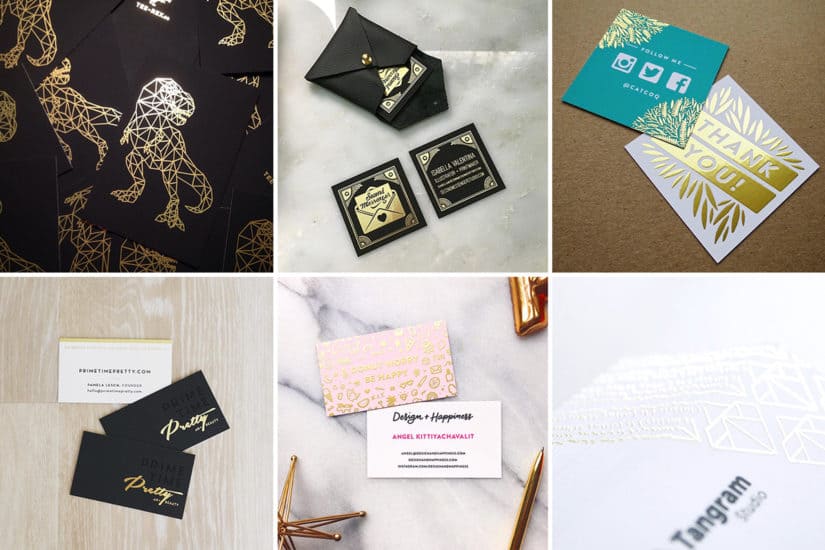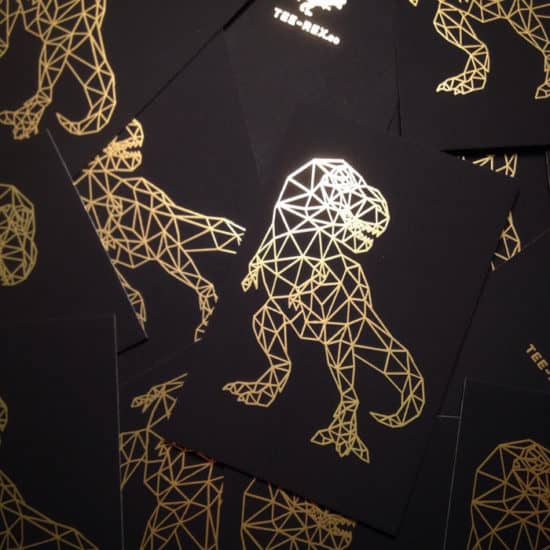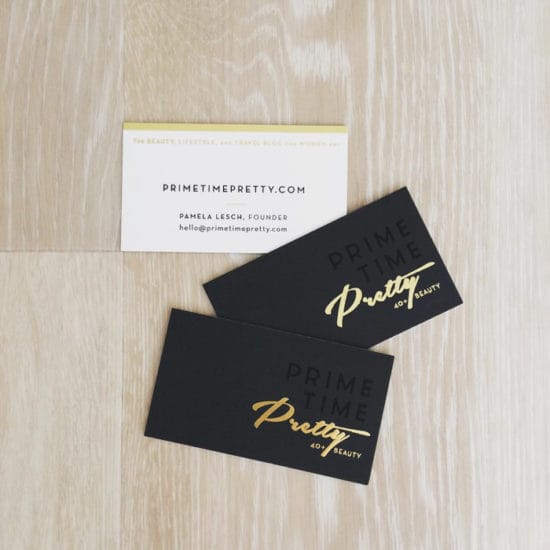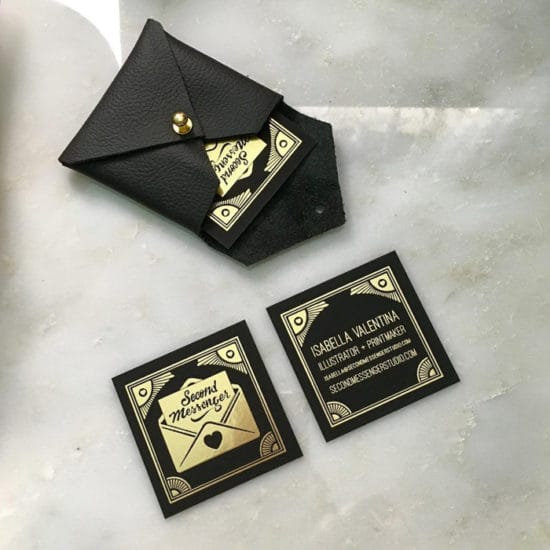#MOOCARDS: You’ve Got the Golden (Foil) Touch

One of our favourite things ever is seeing your #MOOcards all over the internet. To celebrate the launch of our new Tailored design templates, here’s a selection of MOO Gold Foil Business Cards that gave us serious goosebumps.
Tee-Rex
London-based clothing brand Tee-Rex have used fine gold lines to outline the graphic illustrations of dinosaurs that have since become their signature designs. Had you ever seen a dinosaur with gold teeth? Neither had we!

Follow: @teerex.co.
Prime Time Pretty
Self-confessed lifestyle brand and ‘beauty-chasers’ Prime Time Pretty have opted for MOO’s gold foil to enhance the appearance of their business cards. We think it’s as beautiful as they are.

Follow: @graciousbrands and @primetimepretty.
The Second Messenger
LA-based Isabella Valentina is a talented illustrator and printmaker with a love of retro-inspired images. The gold foil channels the classic, magical vibe and we love the handmade pouches for the square business cards.
Follow: @thesecondmessenger.
Design + Happiness
California-based designer Angel Kittiyachavalit made us all kinds of happy by choosing to apply the MOO gold foil onto a dusty pink background. Her site, Design & Happiness has lots of inspiring images and we can’t get enough of her Instagram either!
Follow: @designandhappiness.
Cat Coquillette
We are major fans of freelance illustrator and artist, Cat Coquilette. She’s designed everything from wine labels to wall clocks and with metallics being a common theme throughout her work, we loved to discover her use of our gold foil on our square cards. No, thank YOU Cat!
Follow: @catcoq.
Tangram Studio
We discovered this application of our gold foil when ultra-cool Netherlands-based agency Tangram Studio wrote about it for their blog. The gold looks great against our white paper stock and gives the cards an extra edge that’s both subtle and stunning.
Follow: @hannekedewit.
Gold foil is part of our new Tailored collection which includes Raised spot gloss, and spot gloss. With the launch of our design templates it’s never been easier to give your cards the special treatment.
The Basket Room was born when two fashion graduates, with a love for sustainable fashion and travelling, came together six years later after spotting a gap in the interiors market for beautifully made, handwoven baskets.
Each unique piece of their collection has been produced by communities of talented local weavers from across East Africa providing them with a sustainable income and the recognition they deserve. The baskets not only look good, they do good too. They caught our eye at a recent event after they were using MiniCards as labels on their products.
“We chose MOO products because we felt they were in keeping with our branding: colourful, clean, and modern. The website is so user-friendly & the print quality high. We love the quirky elements that bring a whole new level of fun to printing Business Cards & Flyers.”
Holly started her ethical journey in fashion on a road trip from South Africa to Nairobi, when her eyes were opened to another side of the industry. Camilla quit her fashion job in London to explore her dreams of sourcing intricate and locally crafted decorative products from this East African hub of creativity.
We used MiniCards as we needed a swing tag for our pop-up sales, to communicate our story and the prices. They are neat, unique and complimentary of the product they are promoting. We were extremely happy with the design & print quality, so we started to print our Business Cards and promotional Flyers with MOO. One design feature that sold it for us is the ability to print multiple images on one side of the cards, genius!
Now they split the work of importing and selling these beautiful baskets between the bases of Nairobi, London and Oxford.
Start making your MiniCards.
Photographs from: The Basket Room
Here at the MOOLabs we’re always looking for new ways to help you raise awareness of your business. With this in mind, we recently used our NFC-enabled Business Cards + in a brand new way. To send a tweet. This means that your cards will post a tweet automatically when they are tapped on an NFC-enabled Android or Windows device.
We were able to do this thanks to our integration with IFTTT– the following tutorial will show you how you can set this up.
1. Create a new recipe
Once you’ve created an IFTTT account, Create a Recipe from the My Recipes section.
2. Choose a Trigger
The first step in creating an IFTTT recipe is defining the trigger that launches the recipe. In this case, we want to choose a trigger from the Maker channel. The Maker Channel is the do-it-yourself channel that allows us to link MOO’s Business Cards+ Actions to IFTTT recipes.
3. Choose an event name
When you create a trigger in the Maker Channel, you’ll need to give it an Event Name this is what you can use as reference when you’re linking it to your cards.
4. Link the Recipe to Twitter
Now you can link the recipe to Twitter so that you can post a Tweet. If you haven’t already linked your account to Twitter, you’ll need to be logged into your Twitter account and authorise IFTTT to post to your account.
5. Post a tweet
Choose the option to ‘Post a tweet’. After that you may write the message to be tweeted each time a card is tapped. IFTTT allows you to include Ingredients such as the date & time of the Tweet with the Occurred At ingredient. This is useful because Twitter won’t allow two identical tweets to be posted consecutively, so you’ll need to include the date & time to differentiate tweets coming from multiple taps of the same card. Finally save your tweet message with the Create Action button
6. Create the recipe
Finally, choose Create Recipe to save the recipe.
7. Get your Maker Channel key
From the ifttt.com/maker page, you can find your key and copy it. This links your IFTTT account to your MOO NFC Action.
8. On MOO.com — Choose your NFC Business Cards+ Actions
Whether ordering a new pack of Business Cards+ or from Your Account » Manage Paper+ you can choose actions for your pack of cards.
9. Choose Action: Trigger an IFTTT Recipe
From the Action Chooser choose the action, Trigger an IFTTT Recipe and enter the details you entered when creating your IFTTT Recipe. Namely, you want to copy your Secret Key and your Event Name into the appropriate fields.
Finally, choose a website as the destination to appear when you tap one of the cards on a mobile.
Save this Action to the cards in your pack with the Apply Action button.
10. Done!
If you’re ordering cards, finish saving your Actions to the pack with the Done button.
Now your cards will be able to send a tweet whenever someone taps them!
Discover Business Cards+.
Written by Kai Turner
You’re at the starting point of your business. You’ve pored over your business plans, written a brand manifesto, perfected your products and you’re finally ready for business! But…now what? With so much effort going on the ‘start’ bit, have you thought about the ‘keep going’ part?
Similar to a sports huddle (but with a little less body contact), they are about getting your team together to strategize, review tactics, motivate each other and celebrate wins. While we understand that all businesses are different, these meetings should give you a framework to work to making sure you and your team are connected and doing well.
Weekly Review
Why?
These weekly meetings keep you focussed on the details like sales figures, source of orders or leads and the all-important customer feedback. The aim is to identify any positive or negative trends and take short-term actions to improve for the next week.
Who?
No matter the size of your business, you’ll need to assemble those people who can update on key areas of the operation. This means you’ll need the person who’s running the business and making commercial decisions, the person who delivers the product or service (i.e. customer facing if applicable), if you have a website or have a digital component to your business the technology manager should also attend, the marketing manager and finally the person in charge of customer service and sales.
This group is your ‘A-Team’, you’ll be calling on them throughout the year.
What to ask:
Performance:
– You need to measure success
– How did my sales or leads or actions go last week?
– How does it compare to previous weeks?
– Am I seeing a trend?
Product or service mix:
– Which product or service did I sell most?
– Are my promoted products or services (if relevant) selling compared to my expectations?
– Did the promotion give us the result we want in the short term or long term?
Customers:
– What feedback did I get from customers?
– Is there any trend suggesting there is something I can either fix or improve?
Monthly Review
Why?
The aim of the game here is to look at the last month’s activity, which can show more trends that might be seasonal (e.g. January is a slower month for sales but good for leads) and for you to adjust next month’s tactics. You’ll need a month review from all the main areas of your business like sales, product, marketing, operations and customer service, and HR.
Who?
As with the weekly reviews, you’ll need to assemble your A-Team again and also invite whoever is responsible for human resources too (if they are not already represented by the business/general/operations manager).
What to ask:
Performance:
This means performance tracking whatever you’re measuring success on. This could be revenue, orders or new signups to your service.
– How was revenue/orders/signups/users for the month?
– How does it compare to last month and the same month last year?
– Which of your customer groups is performing the best?
– Do we have enough of the right people to succeed?
– Do we need to hire?
Costs & Margin:
It is really the time to look at your margin and your unit economics. You want to know how much an average customer spends with you versus how much you spent acquiring that customer, so assess any marketing and promotional activities too.
– What were my costs?
– How is the split between the variable and fixed?
– Are my variable costs in line with my revenue growth?
– Did I get as many customers as I expected?
– Are customers coming back?
– Am I getting enough customers to sustain and grow my activity?
– What can I do to bring more of them back, and more often?
– How are people hearing or finding out about my business?
Product offering:
Separate from your on-going product or services iterative improvements and cycle, you should regularly question whether you missing a potential opportunity and really understand your product.
– What are my best or worst selling products?
– Should I push some products forward?
– Based on customer feedback, can I make some changes to my product mix?
Quarterly Reviews
Why?
Much as you would during a football game, take some time out every quarter to assess how you’re doing and make any tactical changes. As well as the regular performance metrics, now’s the time to dig a little deeper into your customer bases and find out who needs a little attention. It’s the perfect opportunity to look around and see what your competitors are doing too – this will ensure you’re keeping ahead.
Who?
Call on the A-Team again! If your organisation is larger, invite your CEO, or a senior team member who is less involved in the day to day execution and can help provide a broader observations and suggestions.
What to ask:
Customers:
– Who are the customers who spend the most or the least?
– What do valuable customers have in common?
– What segments of my customer base are the most valuable?
– How can I encourage customer loyalty?
Competition:
– What has changed in my competitive landscape?
– Are there new players?
– What important actions have my competitors taken (a special sale, a new product or service, a marketing campaign, a new customer target, a change in pricing etc.)?
– Is there a social/political/technological change that I need to consider?
Annual Review or Forecast
As your year’s trading comes to a close it’s time to reflect and consider how you went according to your planned goals. This is an opportunity to review all aspects of your business and look ahead to the next year. This meeting should be deeply insightful drawing on all of the reviews you’ve done throughout the year and inform what you set out to achieve next year.
Who?
As always, your A-Team, and any senior decision makers. If you’re running a larger business, including a facilitator can be useful. They will not know the ins and out of the company but will facilitate workshop with the A-team to create good team dynamics, or help to think about the organisation structure and design.
What to ask
USPs/ Positioning/ Pricing:
– Do my Unique Selling Propositions still hold?
– Am I still different from the other players in the market? If so, why?
– Are there new products or services I should consider selling?
– How would that differentiate me or bring me to par with competitors?
– Are there segments of the market that my main competitors are overlooking?
– Has my competitors’ pricing changed?
– Is my pricing still positioning me appropriately in the market?
High-level business goals:
– What am I planning to spend in the next 12 months?
– What are the coming marketing or product investments?
– What return am I expecting from them? Should I go ahead with them as planned?
– Can I afford major investments without putting other areas of my business at risk?
In the world of business you never know who’s going to throw a curveball, but these planning these regular huddles are designed to give your ‘A-Team’ the advantage. Good luck!
Written by Karim Fadlallah, MOO’s Head of Strategy and Planning
Craft a successful and engaging brand with a brand manifesto – and shout it from the rooftops! Brands like Apple are so successful partly because they lead with “why” they do what they do and not “what’ they sell. By leading with their emotional standpoint, they’re able to make meaningful connections and long-lasting relationships.
We got some top tips from Sarah Grieb, copywriter extraordinaire. She explains that creating an emotional value is fundamental for winning over your audience.
What do you stand for?
So how are you going to win the hearts and minds of your customers? Have a think about what you stand for. What do you care about? One way to approach this is to create a brand manifesto: a declaration of your beliefs, opinions, motives and intentions’. Here’s a few tips to consider when creating a manifesto with real meaning…
Go back to the beginning
Think about why you started your business in the first place. What were your motivations? What were your goals and aspirations for an optimistic future?
Pull together
Ask colleagues, employees or anyone who knows your business as well as you together to share ideas, more heads are better than one.
Consider your customers
Who are they and what are their biggest passions? Nike understood its sporty audience were active, driven and motivated so their brand slogan” ‘Just do it’ perfectly captured a shared view.
Keep it simple
A brand manifesto can be one line or a series of short statements that sum up your opinions and values.
Be disruptive
Don’t be afraid to be challenge the status quo. Your manifesto could be a rallying cry and invoke a response.
Here are some brand manifestos we love at MOO:
1. The North Face
The North Face live by the statement “Never stop exploring”. They’ve created a highly emotive brand manifesto with this video which captures what they stand for and what they care about. It works because their audience shares this view.
2. Apple
Supports their brand slogan “Think different” and it’s communicated in everything they do. They’re renowned for innovation, pushing the boundaries and challenging the impossible.
3. Levi’s
It sets out an optimistic future, engaging its audience with an active, motivational message reinforces their “Go Forth” campaign.
So, what do you stand for? What is it that makes your business unique? We’d love to hear your manifesto.


















